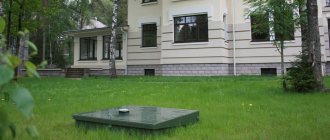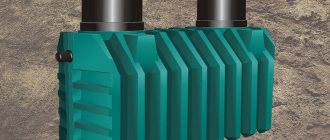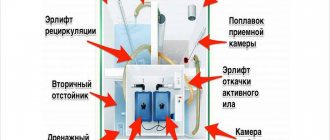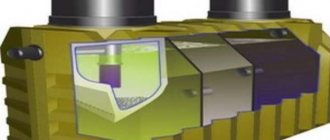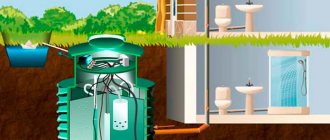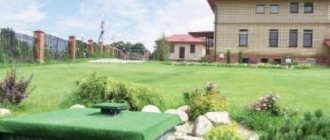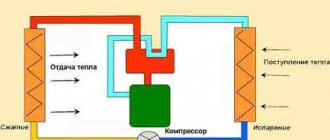Topas is one of the first biological treatment stations in Russia. For more than 17 years of operation, the brand has spread a wide dealer network throughout the country and won the trust of consumers. This is an ideal solution for dachas, cottages and country houses, since the water after the station is odorless and can be safely discharged onto the ground. Unlike septic tanks, Topas is installed in any soil, including clay, and does not require pumping with a sewer truck.
Below we will look at the principle of operation of the Topas septic tank, identify its strengths and weaknesses and touch upon such issues as the use of sewerage in winter, its maintenance and installation.
Topas septic tank body
Topas has a parallelepiped body made of 2 polypropylene sheets 15 mm thick. The sheets are arranged according to the sandwich principle:
- Inside there is a central porous layer that provides good thermal insulation.
- It is protected from the outside and inside by uniform layers.
A few years ago, the Topas body consisted of four sheets that were joined by hand. Because of this, it had little strength and there was a risk of tearing at the corners. Now the sheets are bent on special machines at the factory and joined using polyfusion machine welding. The strength of the connection is almost equal to the strength of the material.
The manufacturer of Topas claims that such a case will last up to 50 years.
Disadvantages of the Topas septic tank body
- Unlike septic tanks with a cylindrical body, Topas has rather thick walls. This is a necessary measure - since the soil pressure on the parallelepiped is uneven, the manufacturer had to strengthen the entire structure. Due to the thick walls, Topas is heavy, and in most cases special equipment is required to install a septic tank. This entails additional costs for equipment rental and sand. The landscape also suffers.
- The body of the Topas septic tank has one more drawback - the absence of pronounced lugs. Because of this, the client often has a question about whether the Topas septic tank will float up when the groundwater level rises. Answer: if there is a sufficient amount of water in the installation chambers, it will not float up.
Important! During servicing, water cannot be completely pumped out of the septic tank chambers. This results in the housing being pressed in.
Design Features
Topas septic tanks are autonomous biological treatment modules. If you look at the parameters of the device, you can see that they are significantly different from the parameters of Russian competitors. The benefits are as follows:
- The level of wastewater treatment is 96-99%;
- The models are compact in size. Easy to install;
- Minimum power consumption;
- Work in silent mode;
- High degree of automation;
- No odors due to excellent sealing.
Some models are quite capable of purifying significant volumes of wastewater. That is, several households can be connected to one treatment plant.
Based on this, we can say that this type of autonomous sewage system can be used not only in the private sector for individual houses, but also for entire neighborhoods or enterprises.
The device is powered by electrical voltage. Therefore, when it is de-energized, its use is prohibited. This will eliminate the possibility of the septic tank breaking.
If we draw an analogy with conventional plastic wastewater tanks, the Topas septic tank has a complex design aimed at the biological treatment of wastewater. Inside, in one of the containers, there is pumping equipment and automation designed for an optimal cleaning regime.
Please pay attention! All operation of the device is carried out according to the established program. It operates successfully due to the well-developed structure and internal circuitry of the device.
Methods for draining drainage in Topas septic tanks
Topas stations can be gravity flow or with forced drainage. Gravity flow ones are installed in dry soil with a low groundwater level. Water can be discharged into a filter well, onto a steep slope or into a deep ditch (from 80 cm in depth). Water drainage from the station is forced if there is clay and/or high groundwater level on the site.
Important! The water coming out of the station is warm, so in winter the discharge onto a slope or into a ditch does not freeze.
The Topas septic tank with forced drainage of wastewater has a pre-installed pump compartment. It is located in the receiving chamber and is connected to the secondary settling tank by a pipe (Fig. 2). For gravity stations, the outlet is located in the secondary settling tank chamber. During production, the inlet and outlet holes in the body are not cut; they are made by installers when installing a septic tank on site.
Septic tank Topas 4 with forced drainage
Peak reset
When choosing Topas, it is important to take into account such a characteristic as peak discharge (maximum one-time discharge, salvo discharge). This is the maximum volume of wastewater that a septic tank can accept in a short period of time.
Sewage waste initially enters the receiving chamber of the septic tank, where it undergoes primary processing. The size of the receiving chamber is limited; it physically cannot accept a large number of wastes. More precisely, it can, but such an action will cause an overflow.
For example, the salvo discharge volume of Topas 4 is only 175 liters, Topas 5 is 220 liters, Topas 8 is 440 liters.
Why is this indicator important? Let's say you want to install a full-size bathroom in your country house. Bathroom volume is approximately 170 liters. After draining just 1 bathroom in Topas 4, you will no longer be able to use the sewer until the wastewater is processed and the receiving compartment is free to accept a new portion.
Electrics in the Topas septic tank
The movement of drainage in the Topas septic tank is carried out due to the operation of one or two compressors. They do not require large amounts of electricity, power consumption is only 60-80 W. The compressors are very reliable, operating from 5 to 7 years, which exceeds the service life of, for example, a submersible pump.
To eliminate the risk of flooding of the compressor unit with water from the station, an alarm is installed. It consists of a float and a large lantern, which is located on the lid of the septic tank. When the water level in the chambers rises to a critical level, the float reacts to this and the lamp lights up. The light of the lantern informs the user that something is wrong with the station and it is necessary to suspend the operation of the sewer system.
It is important to understand that installing an alarm system is a prerequisite. If for some reason the Topas septic tank floods (for example, a submersible pump fails), then without an alarm the user will not know about it until the compressor unit is flooded with water. After this, the compressors will have to be completely replaced.
If the company you contacted to install a sewer system does not indicate an emergency sewer system in the CP, then they will either sell it to you at exorbitant prices on the spot, or, in order to reduce the cost of installation, will not install it at all.
installs an alarm system for a Topas septic tank free of charge as a gift to the client.
Drain circulation in Topas and Topas-S septic tanks
Topas stations are dual-mode. Switching modes occurs depending on the water level in the receiving chamber, which is controlled using a float.
Direct phase.
When water enters the septic tank, the first compressor turns on. It supplies compressed air to the main airlift, the fine bubble aeration element in the aeration tank and the circulation pump. There is an active cleaning of incoming wastewater and removal of purified water from the septic tank.
The diagram shows the circulation of the drain in the direct phase:
water from the house enters the receiving chamber (flow homogenizer), then through the main airlift into the aeration tank; From the aeration tank, the runoff flows through the recirculation airlift into the secondary settling tank and is sent to the exit of the station.
Reverse phase.
If wastewater does not flow into the installation for some time and the water level drops to operating level, the second compressor is turned on. It supplies air to the aerator in the receiving chamber and the airlift of the aeration tank. The airlift of the aeration tank pumps wastewater from the aeration tank to the SI, and from there the water flows by gravity into the receiving chamber. Due to this, the water level in the PC rises and the direct phase is switched on. Thus, the water follows a circle, bypassing the secondary settling tank, even when the sewer is not used for some time. As a percentage, the station operates in the forward phase 70% of the time, in the reverse phase – 30%. Compressors do not duplicate each other, so if one compressor fails, the second one will not be able to work for two.
The diagram shows the circulation of the drain in the reverse phase
: the airlift of the aeration tank is turned on, due to which the runoff from the aeration tank enters the sludge stabilizer; then the water flows by gravity back into the receiving chamber.
The Topas-S station also operates in two modes, but has only one compressor. It is constantly on and switches from mode to mode using a solenoid valve. The price for Topas-S is lower, but the risk of failures for this station is higher, and the service life of one compressor is exhausted faster. Accordingly, it will have to be changed more often. Also, to reduce the load on the only compressor, Topas-S abandoned the recirculation airlift. From the aeration tank chamber, water enters the secondary settling tank only by gravity.
Station Topas-S 4 gravity
Service
Autonomous wastewater treatment plants, which include the Topas septic tank, are often called sewerage without pumping. This does not mean that the installation does not require maintenance at all. The point is that there is no need to call a sewer truck, but it is necessary to remove sludge periodically. How often? 1-4 times a year, depending on the intensity of use.
This is what a Topas septic tank looks like
It is also periodically necessary to remove from the receiving compartment fragments that bacteria cannot process. This operation is carried out with a net by opening the lid. And one more procedure is cleaning the filter for large fractions and airlifts. The efficiency of the installation depends on their condition.
Cleaning filters
Another operation that must be carried out regularly is cleaning the filters on the pumps. To do this, you need to unscrew the large plastic nuts that are located on the top of the pumps. By removing the nuts, you can lift the covers under which the filters are located. If the filters are clean, you don’t need to do anything with them; if there is contamination, they are washed in cold running water, dried and put back in place.
To clean the filters, unscrew the nuts
Removing excess sludge
Excess activated sludge, which is formed during operation, enters the stabilizer chamber, where it is mineralized. They must be removed from this compartment periodically. The recommended frequency of the procedure is once every three months, but many determine that the time has come by the appearance of a smell, which indicates that sludge has accumulated. Removal occurs using a pump (air lift) located in the stabilization chamber. This process is simple, all you need is:
- Turn off the power (toggle switch).
- Put on gloves and place a bucket.
- Open the plug.
- Lower the hose into the bucket and turn on the pump.
- After cleaning the chamber, fill the chamber with clean water and close the cap.
This operation can be carried out using a fecal pump. In this case, pumping can be done once a year.
Cleaning the filter and airlifts
During operation, the filter and airlifts become dirty, which affects the efficiency of wastewater treatment. To restore them they need to be cleaned. This is done using a powerful stream of water; the air cleaner nozzles are cleaned manually - using a needle. The procedure for cleaning a Topas septic tank is as follows:
- Turn off the power.
- Disconnect the air supply hoses and remove the pumps from the housing.
- Spray with a stream of water under pressure - outside and inside.
- When cleaning the air cleaner, clean the nozzles with a needle.
- Put everything in place, add water to the operating level, turn it on and check the operation.
This is all the necessary maintenance work for the Topas septic tank.
Advantages and disadvantages of the Topas septic tank
pros
- Thanks to its design and the presence of a receiving chamber-averaging chamber, the Topas biological treatment station can operate both with constant and periodic use. The degree of wastewater treatment does not change and remains consistently high.
- Topas airlifts are spiral; they do not bend during operation, unlike conventional smooth hoses.
- The Topas body is strong with strong welds. The service life declared by the manufacturer is 50 years. The warranty on the housing is 5 years.
- Maintenance of the Topas station takes place without calling a vacuum cleaner. The sludge from the septic tank is pumped out by a service technician or independently, then this sludge can be used as fertilizer for non-fertile plants.
Minuses
- The shape of the body of the Topas septic tank is a parallelepiped, therefore excess silt can accumulate at the bottom of the septic tank in the corners. Regular cleaning helps combat this.
- The airlift in the receiving chamber is equipped with a coarse fraction filter, which can become clogged during operation. This can be avoided if you do not throw non-degradable garbage into the sewer and carry out maintenance work on time.
- The station is dual-mode, and a lot of electricians are needed to ensure its operation. There have been reliable single-mode stations on the market for a long time, and they cost less than Topas.
- Changing modes in the station occurs only if the float switch works correctly. However, it may fail or, due to adhering debris, drop below the water level, and then the station will only operate in reverse mode.
- The manufacturer's kit does not include an alarm system.
Installation and commissioning
Installation of a Topas septic tank begins with marking the site - it is necessary to determine the optimal installation position. There should be no large trees or bushes nearby; it should be located so that sewer pipes from the house do not have to be pulled very far, but at the same time, it is convenient to send the purified water for further processing.
Installation
A pit is dug in the selected location. Its dimensions are 30-40 cm larger than the dimensions of the septic tank body. The depth should be such that only the manhole cover remains on the surface. It must be remembered that a 10 cm layer of sand is poured onto the bottom of the pit.
The pit has been dug, it is necessary to level the bottom and add sand
The pit is dug to the required depth, the bottom is leveled, then sand is poured 5 cm thick, each layer is spilled and leveled. The latter needs to be leveled “to the horizon” - using a rule or an even bar on which the level is set.
A trench is being dug towards the pit from the house. Its depth depends on the level of the home sewer outlet. The width of the trench is at least 25 cm, but it is very difficult to work in one, so it usually turns out wider. When digging a trench, remember that the pipe must go from the house towards the septic tank with a slope of 2 cm by 1 meter. Making the slope more or less is not recommended. With a larger slope, the water will drain away quickly, and solid particles will remain in the pipe; a smaller slope will not provide the required speed of movement of the wastewater.
Sand is poured onto the leveled bottom
The bottom of the dug trench is leveled, a 10 cm layer of sand is poured onto it, compacted and leveled, forming the desired slope. A polypropylene sewer pipe for outdoor use is laid on the sand. Its diameter is 110 mm. When connecting sections, in addition to the O-rings, the joints are coated with silicone sealant for external use.
The pipeline is connected to the outlet of the drain and laid with a given slope in the trench. The slope is checked using a level. The pipe is filled with sand (not soil), which serves to compensate for soil pressure during frost heaving. They fill it up so that the top of the pipe is covered with sand.
The pipe is laid at the bottom of the trench and covered with sand.
In the same trench, along the sewer pipe, a power cable is laid that goes to the Topas septic tank. They usually use VVG cable 4*1.5 mm. It is laid in a HDPE pipe (low pressure polyethylene pipe) with a diameter of 20 mm. The cable, wrapped in a protective sheath, is laid in a trench and brought into the house, where the cable ends with a plug. The second end of the cable will need to be connected to the septic tank.
The power cable is laid in a protective sheath
The next stage of installing an autonomous Topas sewer system is installing the device in a prepared pit. It must be lowered carefully, without hitting it. Polypropylene, although a durable material, is still plastic, so it can crack upon impact. You can lower the Topas septic tank manually or using a crane. To allow the ropes to be securely fixed, there are holes in the ribs running along the perimeter of the body. A rope is pulled through them. One at the bottom, the second in the middle of the height. The rope should span two opposite sides of the body.
We thread a thick, reliable rope
Holding these ropes, the installation is carefully lowered into the pit. Then, placing a level on the lid, check how level the Topas septic tank is.
Carefully lower it into the pit
There remains a gap of 20-30 cm between the walls of the body and the pit. It must be filled with sand. Gradually, we fill the walls in a circle, while simultaneously filling the septic tank with water. At the same time, we make sure that the water level and the sand level are approximately equal. Having poured a layer of 40-50 cm, the sand is spilled with water. At the same time, it becomes denser and falls lower in level. So, gradually, the pit is filled to the top. After this, we can assume that the Topas septic tank is installed, and the installation and connection of its equipment begins.
Installation of equipment
First we connect the power cable. To do this, remove the protective cover on the input box and connect the wires to the mounting plate in accordance with the diagram. The ends of the conductors are stripped of 0.8-1 mm of insulation, inserted into the appropriate sockets, and secured with clamping screws.
Connecting the power cable
The next stage is connecting the sewer system from the house. It is brought to the septic tank itself. In the place where the pipe will enter the body, draw a circle around the pipe. Then a hole is cut out using a jigsaw.
Cutting a hole in the body
The hole is coated with silicone sealant. A piece of pipe with a socket at the end is inserted into it so that it grows
The rub is on the outside, and it should fit snugly against the body (you can tap it with your fist to make it fit well). The resulting joint is sealed by fusing a 7 mm thick polypropylene tape.
We seal the joint with polypropylene
The sewage system supplied from the house is connected to the installed section of pipe (do not forget to coat the joints with silicone).
We connect the sewer from the house
Next we install the pumps. There are markings inside the case: numbers “1” and “2” on the sockets, on the pipes and on the shelf. The SAME numbers are on the pump housings.
Markings on the body
We install the pumps according to this marking, connecting pipes to their inputs (visible in the photo above). We install flexible couplings on the nozzles, put the other end on the pump inlet, and plug the plug into the socket on the body with the same number.
We connect the pipes to the pumps
We don't mix up the wires
Actually, at this point we can assume that the Topas septic tank has been installed. All that remains is to carry out a test run. To do this, connect the Topas autonomous sewer system to the network and begin pouring water into the receiving compartment (no drains yet). Until the compartment is full, the float sensor is at the bottom, air flows into the receiving chamber. When the water level reaches a certain point, the float will float up, and the air supply will switch to the air tank - the second pyramid compartment. Then all that remains is to start using the sewer, monitoring the results of cleaning. Let’s say right away that in the first month, with intensive use, the drainage may be cloudy. This is because there are still few bacteria and they do not fully cope with their task. After a month the situation should improve.
